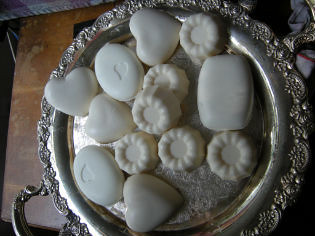
Lye or sodium hydroxide (or NaOH), is needed for cold process soap, what this book and website is about specifically. Also known as caustic soda, it is a caustic metallic base. Lye or sodium hydroxide creates a strong alkaline solution when dissolved in water. It is used in many industries as a strong chemical base in the manufacture of pulp and paper, textiles, drinking water, soaps and detergents and as a drain cleaner. Because Sodium Hydroxide is a common base in chemical labs, 45 millions tonnes plus are produced each year. Basically, lye is an electrolysised salt, a pure sodium hydroxide that is considered a solid; available in pellets, flakes, granules and as a 50% saturated liquid solution. I bought mine in 50 lbs bags, and this brand resembled salt crystals. Because it is hygroscopic and readily absorbs water from the air, it should be stored in an airtight container, which is also important in the case of a liquid spill into the sodium hydroxide, as it would start activating. A Lye or sodium hydroxide solution will leave a yellow stain on fabric and paper.
When I had my soap store, often people would ask if there was lye in the soap, because they wanted soap without it, like glycerin soap they said. We had to tell them that all soap has it, even the melt and pour/glycerin type bars. That the melt and pour that you can buy to make those clear bars, has already been through its oil/water/sodium hydroxide phase.
Because I know people are wary of lye, I've noticed that some soap makers avoid using that word when describing their soaps, in their advertising as well as their labeling. For instance, "naturally saponified" is used, which is legal.
I saw one website where the question was, "What does saponified mean?", the answer was "It is the traditional way of making soap from vegetable oil." When in fact, the traditional way of making soap was lye from wood ashes, water, and animal fats. There really is no traditional way of making vegetable oil soap, it's not old enough to be traditional yet. AND this answer dodges the 'lye' portion of an appropriate and correct answer.
There is also another type of lye called Potassium Hydroxide, which is used for hot process soap. This is also used to make liquid soaps, which may people prefer. Approximately 100 times more sodium hydroxide is made over Potassium Hydroxide. Because potassium soaps require less water to liquefy, they can contain more cleaning abilities (detergent-ness) than liquefied sodium soaps. So when that laundry detergent company states a newer concentrated formula, it means that they are adding less water.
As scary as this item is, it is also in a surprising number of household products. Drain Cleaner can be up to 95 percent lye or sodium hydroxide solution, and some of those anti-wrinkle face creams, they too have a small amount of lye. This creates a very minor burn action on your face, which in return, your skin adds fluids to the area in order to protect itself, plumps up the wrinkles, and thus, the 'appearance' of younger 'looking' skin.
On the internet, I saw an article, complete with images, on how to make soap from ingredients easily found in a grocery store. This included drain cleaner and those toxic room freshener liquid refills for the scent. Avoid doing this for a number of reasons: 1) drain cleaner also has a number of toxic chemicals in it to assist in cleaning drains; 2) using a drain cleaner you would not be able to measure accurately for a decent bar of soap; 3) using an equally toxic room freshener liquid as your scent could be hazardous as well, as not all synthetic liquid scents are for soapmaking.
Gosh, you'd be better off with store brand than a homemade soap like that.


Comments
No response to “Lye, Or Sodium Hydroxide, Can Be Scary When Making Soap, But it May Also Be in Your Face Cream” Post Comments (Atom)
Post Comments (Atom)
Post a Comment |
Post a Comment